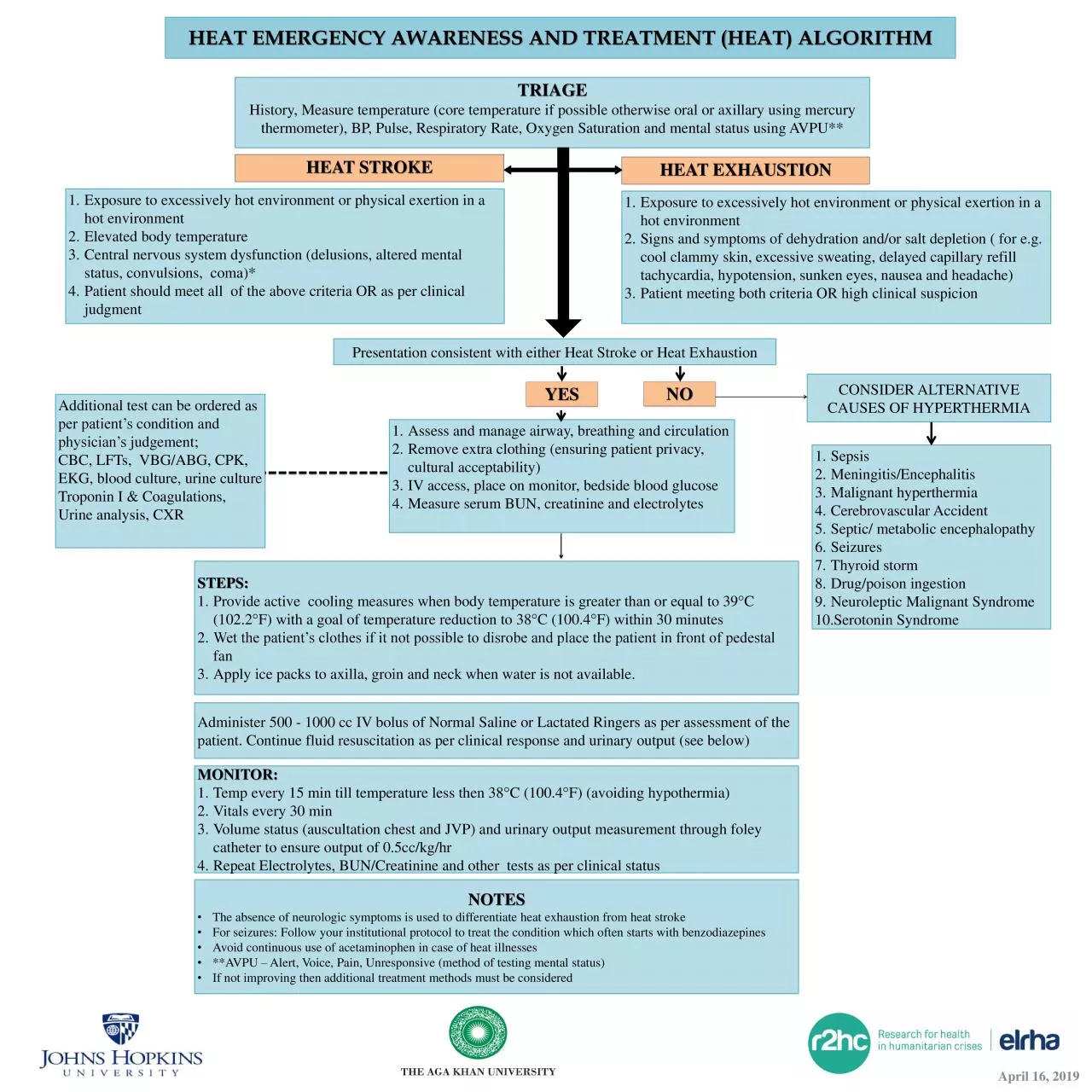

TRIAGE History or axillary using mercury thermometer BP Pulse Respiratory Rate Oxygen Saturation and mental status using AVPU 1 Assess and manage airway breathing and circulation ID: 953824
Download Pdf The PPT/PDF document "Measure temperature core temperature if ..." is the property of its rightful owner. Permission is granted to download and print the materials on this web site for personal, non-commercial use only, and to display it on your personal computer provided you do not modify the materials and that you retain all copyright notices contained in the materials. By downloading content from our website, you accept the terms of this agreement.
TRIAGE History, Measure temperature (core temperature if possible otherwise oral or axillary using mercury thermometer), BP, Pulse, Respiratory Rate, Oxygen Saturation and mental status using AVPU ** 1. Assess and manage airway , breathing and circulation 2. Remove extra clothing (ensuring patient privacy, cultural acceptability) 3. IV access, place on monitor, bedside blood glucose 4. Measure serum BUN, creatinine and electrolytes Presentation consistent with either Heat Stroke or Heat Exhaustion Additional test can be ordered as per patient’s condition and physician’s judgement; CBC, LFTs, VBG/ABG, CPK, EKG, blood culture, urine culture Troponin I & Coagulations, Urine analysis, CXR HEAT EMERGENCY AWARENESS AND TREATMENT (HEAT ) ALGORITHM HEAT STROKE 1. Exposure to excessively hot environment or physical exertion in a hot environment 2. Elevated body temperature 3. Central nervous system dysfunction (delusions, altered mental status, convulsions, coma)* 4. Patient should meet all of the above criteria OR as per clinical judgment 1. Exposure to excessively hot environment or physical exertion in a hot environment 2. Signs and symptoms of dehydration and/or salt depletion ( for e.g. cool clammy skin, excessive sweating, delayed capillary refill tachycardia, hypotension, sunken eyes, nausea and headache) 3. Patient meeting both criteria OR high clinical suspicion HEAT EXHAUSTION YES CONSIDER ALTERNATIVE CAUSES OF HYPERTHERMIA 1. Sepsis 2. Meningitis / Encephalitis 3. Malignant hyperthermia 4. Cerebrovascular Accident 5. Septic/ metabolic encephalopathy 6. Seizures 7. Thyroid storm 8. Drug/poison ingestion 9. Neuroleptic Malignant Syndrome 10. Serotonin Syndrome STEPS: 1. Provide active cooling measures when body temperature is greater than or equal to 39 ° C ( 102.2 ° F ) with a goal of temperature reduction to 38 ° C (100.4 ° F) within 30 minutes 2. Wet the patient’s clothes if it not possible to disrobe and place the patient in front of pedestal fan 3. Apply ice packs to axilla, groin and neck when water is not available. Administer 500 - 1000 cc IV bolus of Normal Saline or Lactated Ringers as per assessment of the patient. Continue fluid resuscitation as per clinical response and urinary output (see below) MONITOR: 1. Temp every 15 min till temperature less then 38 ° C (100.4 ° F) (avoiding hypothermia) 2. Vitals every 30 min 3. Volume status (auscultation chest and JVP) and urinary output measurement through foley catheter to ensure output of 0.5cc/kg/ hr 4. Repeat Electrolytes, BUN/Creatinine and other tests as per clinical status NOTES • The absence of neurologic symptoms is used to differentiate heat exhaustion from heat stroke • For seizures: Follow your institutional protocol to treat the condition which often starts with benzodiazepines • Avoid continuous use of acetaminophen in case of heat illnesses • **AVPU – Alert, Voice, Pain, Unresponsive (method of testing mental status) • If not improving then additional treatment methods must be considered NO April 16, 2019 RISK FACTORS FOR HEAT ILLNESSES Age (less than 10 or gre
ater than 50 years) Individuals working outdoors without shades People living in poorly ventilated areas High number of family members living in relatively small houses Low socio - economic status Exertion in days when both the environmental temperature & humidity is on rise Individuals who have limited functional status or bed bound Comorbidities like diabetes, hypertension, ischemic heart disease, stroke, obesity, chronic respiratory conditions, heamatologic /oncologic diseases, psychiatric illnesses. Recent acute illness or exertion heat injury Lack of acclimatization MEDICATION EFFECT EXAMPLES Anticholinergics Can affect central thermoregulation, reduce cognitive alertness and prevent or reduce sweating Atropine, Ipratropium, Solifenacin , Benztropine , Trihexylphenidyl Antipsychotics Can inhibit the sweating mechanism and reduce systolic blood pressure, central thermoregulation, cognitive alertness and vasodilation Haloperidol, Quetiapine , Risperidone , Clozapine, Olanzapine, Fluphenazine Antihistamines Can inhibit the sweating mechanism and reduce systolic blood pressure Chlorphenaramine , Diphenhydramine, Cetrizine , Fexofenadine, Loratidine . Desloratidine Anti - Parkinson’s Can inhibit the sweating mechanism; reduce systolic blood pressure and cause dizziness and confusion. Sinemet ( carbidopa levodopa), Selegiline , Amantadine, Bromocriptine , Benztropine , Trihexylphenidyl Antidepressants Reduce sweating; some can decrease centrally induced thermoregulation and cognitive alertness TCAs ( Nortriptaline , Amitriptaline ), SSRI(Fluoxetine, Sertraline), Bupropion, Venlafaxine Anxiolytics & muscle relaxants Reduce sweating and increase dizziness, decrease cardiac output and therefore reduce cooling by vasodilation, and worsen respiratory symptoms Benzodiazepines (Diazepam, Alprazolam), Tizanidine , Cyclobenzaprine Sympatholytics Can worsen hypotension in vulnerable patients Beta blockers ( Metaprolol , Propanolol , Carvedilol ) Alpha blockers ( Prazosin , Doxazosin ) Sympathomimetics Can prevent dilation of the blood vessels in the skin, reducing the capacity to dissipate heat by convection Epinephrine, Norepinephrine, Dopamine, Dobutamine , Salbutamol, Albuterol Antihypertensives Can lead to dehydration and reduce blood pressure; hyponatremia is a common side effect and can be worsened by excess fluid intake Calcium Channel blockers (Amlodipine, Nifedipine , Verapimil , Diltiazem ), Angiotensin receptor blockers (Losartan, Irbesartan , Valsartan), Angiotensin converting enzyme inhibitors (Ramipril, Lisinopril), Diuretics (Furosemide, Hydrochlorothiazide, Spironolactone), Nitrates ( Isosorbide mono/di - nitrates) Alpha blockers, Beta blockers Antiepileptics can reduce cognitive alertness and increase dizziness Phenytoin , Levetiracetam , Carbamazepine, Lacosamide , Lamotrigine , Oxycarbamazepine , Valproate, Phenobarbitone Other drug classes such as antiemetics , anti - vertigo drugs, gastrointestinal drugs, urinary incontinence drugs also have anticholinergic effects April 16, 2019 MEDICATIONS INCREASING RISK FOR HEAT ILLNESSE